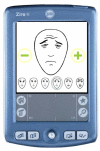Electronic and paper versions of a faces pain intensity scale: concordance and preference in hospitalized children
- PMID: 21989306
- PMCID: PMC3203844
- DOI: 10.1186/1471-2431-11-87
Electronic and paper versions of a faces pain intensity scale: concordance and preference in hospitalized children
Abstract
Background: Assessment of pain in children is an important aspect of pain management and can be performed by observational methods or by self-assessment. The Faces Pain Scale-Revised (FPS-R) is a self-report tool which has strong positive correlations with other well established self-report pain intensity measures. It has been recommended for measuring pain intensity in school-aged children (4 years and older). The objective of this study is to compare the concordance and the preference for two versions, electronic and paper, of the FPS-R, and to determine whether an electronic version of the FPS-R can be used by children aged 4 and older.
Methods: The study is an observational, multicenter, randomized, cross-over, controlled, open trial. Medical and surgical patients in two pediatric hospitals (N=202, age 4-12 years, mean age 8.3 years, 58% male) provided self-reports of their present pain using the FPS-R on a personal digital assistant (PDA) and on a paper version. Paper and electronic versions of the FPS-R were administered by a nurse in a randomized order: half the patients were given the PDA version first and the other half the paper version first. The time between the administrations was planned to be less than 30 minutes but not simultaneous. Two hundred and thirty-seven patients were enrolled; 35 were excluded from analysis because of misunderstanding of instructions or abnormal time between the two assessments.
Results: Final population for analysis comprised 202 children. The overall weighted Kappa was 0.846 (95%CI: 0.795; 0.896) and the Spearman correlation between scores on the two versions was rs=0.911 (p<0.0001). The mean difference of pain scores was less than 0.1 out of 10, which was neither statistically nor clinically significant; 83.2% of children chose the same face on both versions of the FPS-R. Preference was not modified by order, sex, age, hospitalization unit (medical or surgical units), or previous analgesics. The PDA was preferred by 87.4% of the children who expressed a preference.
Conclusion: The electronic version of the FPS-R can be recommended for use with children aged 4 to 12, either in clinical trials or in hospitals to monitor pain intensity.
Figures


Similar articles
-
A smartphone version of the Faces Pain Scale-Revised and the Color Analog Scale for postoperative pain assessment in children.Paediatr Anaesth. 2015 Dec;25(12):1264-73. doi: 10.1111/pan.12790. Paediatr Anaesth. 2015. PMID: 26507916 Clinical Trial.
-
The Faces Pain Scale-Revised: toward a common metric in pediatric pain measurement.Pain. 2001 Aug;93(2):173-183. doi: 10.1016/S0304-3959(01)00314-1. Pain. 2001. PMID: 11427329
-
Development of the Emoji Faces Pain Scale and Its Validation on Mobile Devices in Adult Surgery Patients: Longitudinal Observational Study.J Med Internet Res. 2023 Apr 17;25:e41189. doi: 10.2196/41189. J Med Internet Res. 2023. PMID: 37067854 Free PMC article.
-
Recommendations for selection of self-report pain intensity measures in children and adolescents: a systematic review and quality assessment of measurement properties.Pain. 2019 Jan;160(1):5-18. doi: 10.1097/j.pain.0000000000001377. Pain. 2019. PMID: 30180088
-
Age-related response to lidocaine-prilocaine (EMLA) emulsion and effect of music distraction on the pain of intravenous cannulation.Pediatrics. 1994 May;93(5):797-801. Pediatrics. 1994. PMID: 8165081 Review.
Cited by
-
Availability of researcher-led eHealth tools for pain assessment and management: barriers, facilitators, costs, and design.Pain Rep. 2018 Sep 11;3(Suppl 1):e686. doi: 10.1097/PR9.0000000000000686. eCollection 2018 Sep. Pain Rep. 2018. PMID: 30324177 Free PMC article.
-
Validation of the Adolescent Pediatric Pain Tool for the Multidimensional Measurement of Pain in Children and Adolescents Diagnosed with Osteogenesis Imperfecta.Can J Pain. 2019 Jul 18;3(1):148-156. doi: 10.1080/24740527.2019.1626705. eCollection 2019. Can J Pain. 2019. PMID: 35005403 Free PMC article.
-
Pain Management Mobile Applications: A Systematic Review of Commercial and Research Efforts.Sensors (Basel). 2023 Aug 5;23(15):6965. doi: 10.3390/s23156965. Sensors (Basel). 2023. PMID: 37571747 Free PMC article.
-
Enhancing validity, reliability and participation in self-reported health outcome measurement for children and young people: a systematic review of recall period, response scale format, and administration modality.Qual Life Res. 2021 Jul;30(7):1803-1832. doi: 10.1007/s11136-021-02814-4. Epub 2021 Mar 18. Qual Life Res. 2021. PMID: 33738710 Free PMC article.
-
Head motion and perception of discomfort by young children during simulated CBCT examinations.Dentomaxillofac Radiol. 2021 Mar 1;50(3):20200445. doi: 10.1259/dmfr.20200445. Epub 2020 Oct 30. Dentomaxillofac Radiol. 2021. PMID: 33125282 Free PMC article. Clinical Trial.
References
-
- Junker U, Freynhagen R, Langler K, Gockel U, Schmidt U, Tolle TR, Baron R, Kohlmann T. Paper versus electronic rating scales for pain assessment: a prospective, randomised, cross-over validation study with 200 chronic pain patients. Curr Med Res Opin. 2008;24(6):1797–1806. doi: 10.1185/03007990802121059. - DOI - PubMed
-
- Marceau LD, Link C, Jamison RN, Carolan S. Electronic diaries as a tool to improve pain management: is there any evidence? Pain Med. 2007;8(Suppl 3):S101–109. - PubMed
Publication types
MeSH terms
LinkOut - more resources
Full Text Sources
Medical
Miscellaneous

